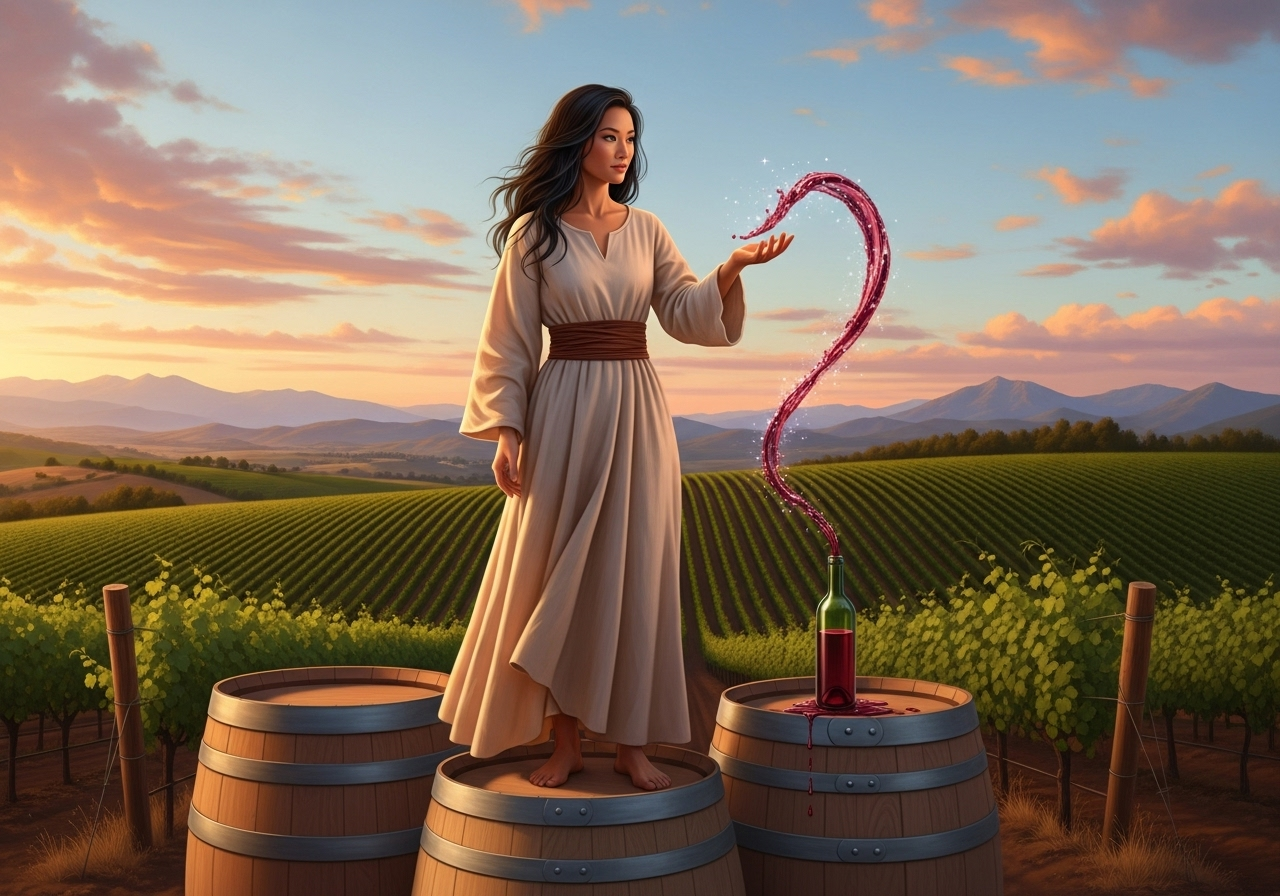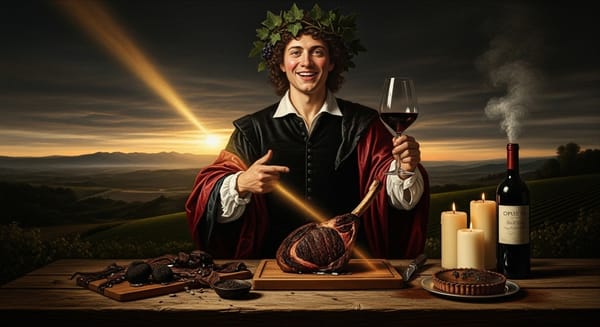Oakville AVA: A Powerhouse in the Shadow of the Vaca & Mayacamas Mountains
Explore Oakville, Napa Valley’s powerhouse AVA. From Crabb’s To Kalon roots to Screaming Eagle’s mythic allure, discover how volcanic east and gravelly west craft Cabernets that marry muscle with poise.

Prelude: Heat in a Glass
Heat rises off Highway 29 like a mirage, but in the narrow band that is Oakville that shimmer turns tactile—berry‑scented, cedar‑lined, pulsing with restless ambition. I first felt it standing at the crossroads of Oakville Cross and the Silverado Trail, the Mayacamas behind me, the Vaca Range ahead. The valley floor breathed warm afternoon sun, yet a marine veil still clung to the musty under‑rows, a residue of dawn. In that daily tug‑of‑war—heat courting cold, vigor courting restraint—Cabernet Sauvignon finds both muscle and poise. Oakville is not a place one merely visits; it is a place that visits you, staining memory the color of garnets and old love letters.
Oakville matters because it refuses to settle for power or elegance alone. It stages a duet where both achieve equal billing, supported by a stage crew of weather, soil, and humans who edit relentlessly. What follows is part chronicle, part field note, and part love song—three movements converging on a single note: Oakville.
Roots Beneath the Dust of Time
From Wheat to Wine
Long before Cabernet’s rise, this slice of Napa Valley wore a russet cloak of wheat. The grain rustled under dry summer wind until a restless New Yorker named Hamilton Walker Crabb, ex‑horticulturist and consummate tinkerer, turned furrow into vine. He called the ranch To Kalon—“the highest beauty”—a phrase that reads like prophecy in hindsight. By 1868 Crabb had stocked more than 400 grape varieties, chasing flavor the way astronomers chase light. His experimental plots functioned as both nursery and university, teaching future growers the vocabulary of rootstock and clone at a time when California agriculture spoke mostly in sheaves.
The railroad soon threaded through town, carrying lumber south and curiosity north. Oakville Station became an agricultural nerve center: barrels rolled onto boxcars destined for San Francisco’s thirsty boomtown bars, while pruning shears and pickaxe heads arrived in reverse. Yet progress remained fragile. When phylloxera swept through in the 1890s, vines withered, leaving skeletal trellises as reminders of mortality. Prohibition followed, a dry decree that echoed like an empty barrel. Only sacramental wine kept the region legally alive, and even that lifeline was frayed.
Families, Visionaries, Rebels
Resilience here often arrived with a family name: the MacDonalds, its early orchardists; the Mondavis, who split ideologically but not spiritually over questions of oak, yield, and future. Groth introduced precision farming when many still relied on intuition; Swanson coaxed Merlot into eloquence. Heitz Cellars, sourcing from Martha’s Vineyard on Oakville’s western flank, proved that mint‑flecked grace could share a bottle with depth. Each newcomer layered another tone onto the chord.
Recognition and Renaissance
By 1993 the federal government awarded Oakville AVA status, but the paperwork only ratified what collectors already chased. The 1990s through early 2000s became Oakville’s second Golden Age: Screaming Eagle hit the auction block like a comet, while Harlan Estate engineered gravity‑defying prices without ever raising its voice.
During this period of clamor, smaller voices refused to drown—names like Rudd, Paradigm, and Detert continued to till modest acreage with monkish focus, keeping the region’s humility intact. The peaceful coexistence of cult and craft remains Oakville’s most unlikely feat.
Earth, Air, and the Pulse Between
A Valley in Stereo
Stand at sunrise facing east and the Vaca Mountains glow before the Mayacamas yawns. The eastern bench is young in geologic time—volcanic, iron‑rich, quick‑draining. Vines grown here develop berries with thicker skins and an assertive tannic spine, like athletes training at altitude. Cross the valley floor—no more than two miles at its widest—and gravelly fans washed down over millennia create a quilt of alluvial loam. This western side confers perfume: black cherry, rose petal, the cool hum of graphite.
Dig two feet and your shovel might clink against river stone, then crumble into sandy loam a few paces later. These quick transitions grant vintners a painter’s palette of micro‑sites. Some exploit slope to harvest sun earlier; others leverage shade to delay sugar accumulation, stretching hang time without sacrificing acidity.
Climate as Conductor
Oakville’s latitude sits at an inflection point: twenty miles south, bayside Carneros pampers Chardonnay under cool fog; ten miles north, Calistoga bakes Syrah beneath relentless heat. Oakville borrows from both. Fog drifts as far as Yountville most mornings, softening sunrise, but seldom lingers past ten o’clock. Afternoon heat spikes approach 95 °F, yet by dusk a coastal breeze sluices down the valley like cold tea poured over ice, dropping temperatures twenty degrees within an hour. The vines shiver, stomata close, respiration slows, and acidity is locked in.
Climate change tugs at this equilibrium. Data from the past three decades reveal rising nighttime lows—subtle, a single breath heavier each year. Some growers now plant cover crops longer into spring to buffer soil moisture; others trial drought‑tolerant rootstocks borrowed from southern Spain. Adaptation is ongoing, a rehearsal that never ends.
Farming the Edge of Restraint
Pruning in Oakville resembles choreography. Workers move down rows like a slow‑motion wave, canes snapping under shears, leaving two‑bud spurs poised for spring. The aim is balanced architecture: enough leaf area to photosynthesize, not so much that midday heat bakes clusters.
Soil Stewardship
Organic certification is common, but the conversation has matured into regeneration. Compost—swirled with grape pomace, straw, and cow manure—returns to row middles each winter. Microscopic fungi form highways between root hairs, ferrying phosphorus in exchange for sugar. Some properties, like Groth’s Hillview Estate, seed flowering cover crops of vetch and mustard to attract beneficial insects, replacing pesticide sprays with predatory wasps and ladybird armies.
Water as Moral Question
Oakville’s vineyards are drip‑irrigated, but the philosophy is deficit rather than indulgence. Season totals might equal a single late‑summer rainstorm in Bordeaux. Tension matters: vines push roots deeper, tapping moisture while picking up mineral whispers of bedrock. When drought years stack, tough decisions follow—thin more fruit, risk dehydration, or water and risk dilution? Most choose frugality, accepting smaller berries for greater concentration.
Harvest Strategies
Pick dates spark debate over espresso shots at Oakville Grocery. East‑bench growers often harvest a week earlier, chasing red fruit and floral lift before September heat caramelizes acids. West‑side estates hang longer, trusting gravel to moderate ripening. Night harvest is standard: crews start at midnight under LED rigs, clusters cool to preserve aromatics, and fermentation vats shiver when fruit arrives at dawn.
Characters in the Oakville Play
Cabernet Sauvignon: The Protagonist
Oakville Cabernet opens like a grand theater curtain: crushed cassis, brambled blackberry, a brush‑stroke of menthol. Mid‑palate, the wine broadens into dark chocolate shavings, tamarind, and a mineral thread reminiscent of gunflint kissed by summer rain. Tannins arrive assertive yet polished—think antique leather rather than new boot.
Supporting Cast
Merlot here is no wallflower. Raised on clay pockets along the river, it gathers blue‑plum swagger and a cocoa‑dust hug, lending mid‑palate generosity to Cabernet‑centric blends. Cabernet Franc appears in cooler parcels, imparting crimson‑rose aromatics and peppery lift. Petit Verdot, a minority shareholder, colors the blend like a drop of indigo in ink, deepening hue and lengthening finish.
A handful of Sauvignon Blanc vines near Oakville Grade translate sunlight into citrus notes—yuzu, finger lime, white nectarine. The grape offers reprieve on tasting flights otherwise dominated by reds but remains rare, a whispered aside in a long speech.
Textural Signature
More than flavor, Oakville’s calling card is texture. The best wines feel like silk pressed against stone—supple at first touch, then structured, then melting. They balance glycerol richness with a line of acidity slender as piano wire, allowing weight without fatigue.
Alchemy in Cellar Shadows
Sorting Truth from Grape
Upon arrival, clusters meet optical sorters lit like airport runways, each berry photographed and accepted or rejected in milliseconds. Some vintners deem this technological triage essential; others trust trained hands to cull the imperfect the old‑fashioned way. Consent is found in outcome: pristine fruit fosters clean fermentations, minimal sulfur, and risk‑embracing native yeasts.
Fermentation Philosophy
Concrete eggs dot cellars like relics from modern mythology, their curved walls keeping skins in perpetual motion, extracting tannin gently. Stainless steel offers sterility and precision, while French oak cuves lend micro‑oxygenation and the faint scent of toasted almond. The chosen vessel often mirrors the winemaker’s temperament—analytical minds gravitate to steel’s data‑rich fermentations; poets favor oak’s subtle conversation.
Extended maceration is common—twenty to forty days on skins—allowing phenolics to polymerize, softening future tannin. Must temperatures peak around 88 °F, yet many winemakers now cap at 82 °F to preserve aromatics, relying on time rather than heat for extraction. Ferments finish dry, below two grams of residual sugar; numbers stay off the label, but the disciplined restraint shows in the glass.
Oak, Once and Future
New French barrels remain the prevailing dialect, often 70–100 % new for flagship cuvées. Yet a quiet rebellion toward larger, neutral vessels gains momentum, especially in drought years where concentration needs no wooden amplifier. Steam‑bent staves replace flame‑toast for subtler spice. The debate is not oak or abandonment but nuance: how softly can wood speak while still being heard?
Names That Echo in Glass
Traveling north from Yountville, you first encounter Groth Vineyards, whose 1985 Reserve Cabernet announced that Napa could equal First Growth heft. Continue westward toward the foothills and Heitz’s Martha’s Vineyard offers eucalyptus‑laced Cabernet that ages like novellas gathering margin notes. Across the valley floor, Opus One stands brisk and symmetrical, a classical mansion scoring its wines with equal parts St. Julien poise and Californian amplitude.
Climb the eastern bench and Dalla Valle rises—terraces cut against rust‑red tuff, wines that taste of black cherry rolled in cacao nib and dusted with sagebrush pollen. South of there, Turnbull shelters heritage clone blocks that feel like agricultural time capsules, each vine a footnote to Crabb’s early experiments. Higher still, on a promontory touching the sky, sits Harlan Estate—its mosaic of exposures orchestrated into a single, seamless chord that critics struggle to parse without surrendering to metaphor.
Further west, tucked behind a copse of oaks, Screaming Eagle remains largely invisible. The little vineyard, rumored under 60 acres, yields a wine so aromatic—wild berries, violets, the burnt‑sugar rim of a crème brûlée—that even the most cynical tasters pause.
What binds these disparate addresses is less a flavor profile than a conviction: site is scripture, and the winemaker’s job is exegesis.
When Time Turns Velvet
Oakville Cabernets arrive on release like tightly coiled springs—energetic, not yet graceful. Five years grants harmony; ten years invites nuance: balsamic‑laced cassis, black tea, worn cedar. Past twenty, tertiary aromas emerge—dried rose petal, cigar box, the distant echo of campfire smoke. Though structure remains intact, flavors glide rather than march, a river slowed but deepened.
Cellaring demands constancy: 55 °F, 70 % humidity, darkness absolute. Stand bottles upright for a day before service, letting sediment settle, then decant gently. Young wines benefit from brisk aeration—an hour or two in a wide‑belly vessel—but older vintages require tenderness, like reading an aged diary at dawn.
Serve at 60–65 °F. Cooler, and fruit retreats behind a wall; warmer, alcohol startles the palate. Pairings lean carnivorous—grilled rib‑eye, lamb with rosemary—but do not ignore vegetarian allies: charred portobello, cocoa‑rubbed beet steak, aged Gouda drizzled with olive oil.
Speculating on Bottled Stardust
Investing in Oakville straddles desire and discipline. Scarcity tilts price curves upward: Screaming Eagle hovers near the stratosphere, while back‑vintage Harlan leapfrogs indexes. Yet raw scarcity alone rarely sustains value; provenance and storage weigh equally. A 1997 Groth Reserve stored under grandmother’s staircase will lag behind a 2001 kept in professional repose.
Value here also accrues from narrative. To Kalon fruit, parceled among multiple wineries, invites debate over terroir ownership, thereby deepening myth and market alike. Climate volatility injects risk but also urgency: collectors speculate that recent drought‑compressed vintages—2017, 2020—may achieve cult status precisely because they are scarce and hard‑won.
Yet treat market chatter as background noise. True return arrives at a dinner table fifteen years hence, when a bottle uncorks conversation between friends who seldom agree on anything except the beauty now blooming in their glasses.
The Echo That Lingers
Oakville is a paradox perpetually resolving: power with grace, fame with humility, sunshine with fog. Its vineyards write music in two keys—volcanic and alluvial, east and west—and its wines translate that score into liquid architecture. To drink Oakville is to taste sunlight braided with loam, ambition tempered by patience, history rewritten each vintage. Long after the glass empties, an echo lingers—warm, mineral, and alive, like dusk captured in a chorus.





